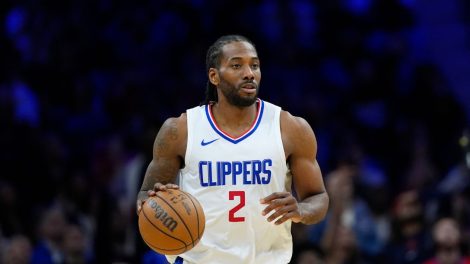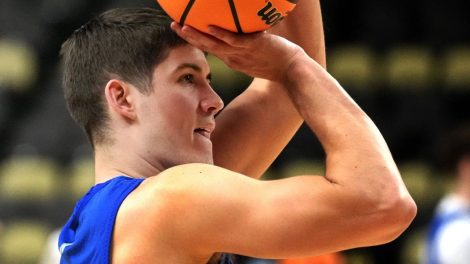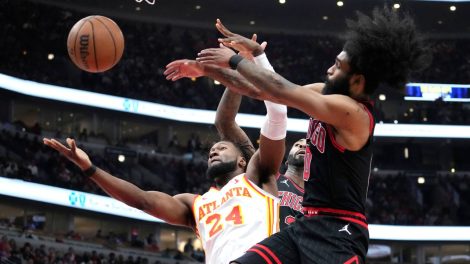The Feb. 7 NBA trade deadline is just under a week away and the league’s hot stove is burning as hot as ever.
New Orleans Pelicans superstar Anthony Davis has asked for a trade, the New York Knicks already traded Kristaps Porzingis to the Dallas Mavericks and, given how competitive the playoff picture is in both conferences, there could be more buyers trying to bolster their rosters this season than usual.
Among the more buyers that could be out there are the Toronto Raptors, whose one-year gamble on Kawhi Leonard has, essentially, boxed them into a championship-or-bust mindset.
There has already been a lot written on who the Raptors might want to target and what their greatest needs are heading into the deadline, but that’s only one aspect of it. The other is the nuts and bolts of how the Raptors might get a deal done.
With that in mind, here’s a closer look at the Raptors’ current and future salary-cap situations and how their finances might impact decisions team president Masai Ujiri and Co. make with the traded deadline so quickly approaching.
NOTE: All salary cap figures are via Spotrac, while collective bargaining agreement details are sourced from Larry Coon’s CBA FAQ.
[relatedlinks]
Current cap outlook
Here’s a summary of the Raptors’ current cap outlook:
| Player | Cap Figure |
|---|---|
| Kyle Lowry | $31,000,000 |
| Kawhi Leonard | $23,114,066 |
| Serge Ibaka | $21,666,667 |
| Jonas Valanciunas | $16,539,326 |
| Danny Green | $10,000,000 |
| Norman Powell | $9,367,200 |
| Fred VanVleet | $8,653,847 |
| C.J. Miles | $8,333,333 |
| Delon Wright | $2,536,898 |
| OG Anunoby | $1,952,760 |
| Malachi Richardson | $1,569,360 |
| Pascal Siakam | $1,544,951 |
| Greg Monroe | $1,512,601 |
| Justin Hamilton | $1,000,000 (dead cap) |
| Lorenzo Brown | $800,000 (dead cap) |
| Patrick McCaw | $786,211 |
| Total: $140,377,220 |
What’s important to understand when taking in this snap-shot of the Raptors’ cap is that total figure: $140.38 million.
This is critical because it happens to be about $38.51 million over the NBA’s salary cap, meaning the Raptors will be paying the luxury tax this season – in a big way (more on this later).
What that table above isn’t telling you, however, is what the Raptors’ cap situation looks like beyond this season — another important factor to take into consideration even for a team that’s as focused on the right now as Toronto appears to be. [sidebar]
Come the off-season, the Raptors will potentially have eight free-agents (two restricted, three unrestricted and three player-options) with another five (one restricted, one club option, three unrestricted) slated for the summer of 2020.
This is valuable in assessing the Raptors’ approach to this coming trade deadline because it paints a picture of where they are from a team-building standpoint.
It’s no secret that the Raptors want Leonard to remain with them past this season and although he’s among the players with a player-option, he’s almost assuredly going to decline that option and become a UFA. As such, while it does make sense for the Raptors to make an all-in kind of move at the deadline, they must also carefully consider the length of term of the player they would be acquiring.
When you consider how many free-agents the Raptors could end up having over the next two off-seasons you can see the built-in reset button Ujiri created when he went and traded for Leonard in the first place. Should he decide to stay, the Raptors can make as many efforts as possible to re-sign their current core. If not, they can let guys walk and begin a tear down just as easily.
Therefore, if the Raptors are going to pull the trigger on a deadline deal, it would be to their benefit to look for players who better align with this two-year window they’ve already set up for themselves.
It’s part of the reason why the prospect of acquiring Davis is so enticing. Not only is he an incredible talent, he’s likely to become a free-agent in the summer of 2020 when so many other Raptors would also be hitting the open market.
Whether the Raptors are in on Davis or not, though, acquiring a player with less term would just make more sense given how their currently built.
Understanding the luxury tax
As mentioned before, the Raptors are $38.51 million over the salary cap and are therefore paying the luxury tax, which is a big deal when it comes to trades they can make.
Because they’re that much over the cap, the Raptors are looking at an approximately $34.1 million luxury-tax bill this season — a number that could go up if certain performance incentives kick in for some players or if they end up acquiring more salary in a trade, as teams are only charged for how their roster looks on game 82 of the season.
Maple Leaf Sports and Entertainment seems cool with footing the bill, but that’s not exactly pocket change and with the potential for that fee to inflate further there could be some reservations about pulling the trigger on a deal.
Being that far over the salary cap is particularly significant for the trade deadline because, as a tax-paying team, the Raptors are held to steeper restrictions when it comes to matching salaries to make a trade work.
In any potential deal Toronto makes, they can only receive contracts worth 125 per cent of the total salary they send away, plus an additional $100,000.
To frame that in a more concrete manner, Davis makes $25.4 million this season. If the Raptors were to make an offer for him — and no other Pelicans players’ salaries were involved in the deal — they would need to include some combination of assets worth around $20.2 million to make the deal legal.
The bottom line of it all is that, while it’s possible for the Raptors to make a deal at the deadline, there are financial hoops they’ll need to jump through in order to make one happen.
What do the Raptors have to offer in a trade?
Players: Pretty self-explanatory, with some players being worth more in a trade than others because of how much money they make, their ability, etc. Remember, with the exception of Leonard and probably Kyle Lowry, there really isn’t anyone on the Raptors who will be considered “untouchable.”
Draft picks: This one becomes interesting because of the season-defining trade for Leonard. In that deal, the Raptors included their 2019 first-rounder and as such are now not allowed to trade their 2020 first-round pick because of something called the “Ted Stepien Rule” which states teams aren’t allowed to trade future firsts in consecutive years. Toronto will be able to deal that 2020 first-rounder after the draft, but that won’t do them much good as far as the deadline is concerned.
Other than that, the Raptors are free to trade picks as far out as 2025 and have all their seconds at their disposal with the exception of their 2020 and 2023 second-round picks which cannot be traded as, in the utterly disastrous event the Raptors somehow miss the playoffs, that lottery-protected 2019 first-round pick they used to help acquire Leonard would then turn into these two assets.
Cash: Though not as highly publicized an asset, straight cash is a tool at the Raptors’ disposal as well. Each team has something called a Maximum Annual Cash Limit, which is an allocation of money determined by the salary cap that a team can use throughout the year before it resets.
This season, the number is $5.24 million and the Raptors have yet to use any of it, meaning they have all that additional money to facilitate a trade.
Of note: The Spurs sent $5 million to the Raptors as part of the Leonard deal and because Toronto accepted that money it can now only receive $243,000 in cash from another team that may be looking to grease wheels on a deal with some Benjamins.
Traded Player Exceptions: A Traded Player Exception, or just trade exception, come about as a result of salary imbalances in trades. For example, a team trading away a $4 million player for a $2 million player would gain a $2 million trade exception.
That trade exception can be thought of as a credit on the team’s budget that allows them to complete trades over the salary cap that they would otherwise not be able to make due to salaries not matching up.
In this case, the Raptors have trade exceptions from the Bruno Caboclo deal to the Kings worth $2.45 million and another one worth $2.95 million from Jakob Poeltl to the Spurs. Neither are particularly valuable, but one of them could be used to help make a trade happen with Caboclo’s being the more likely candidate as it expires a day right after the trade deadline and Poeltl’s not until July 18.
It’s important to note though that these trade exceptions can’t be combined to create one bigger, more valuable asset to facilitate one single trade. They must be used in separate transactions.
Extra roster spot: Toronto currently only has 14 players on its roster, leaving room for one more player. Though seemingly innocuous, this is still something worth mentioning as it means the Raptors could possibly take in one additional player from another team and still make it work in terms of roster space.









